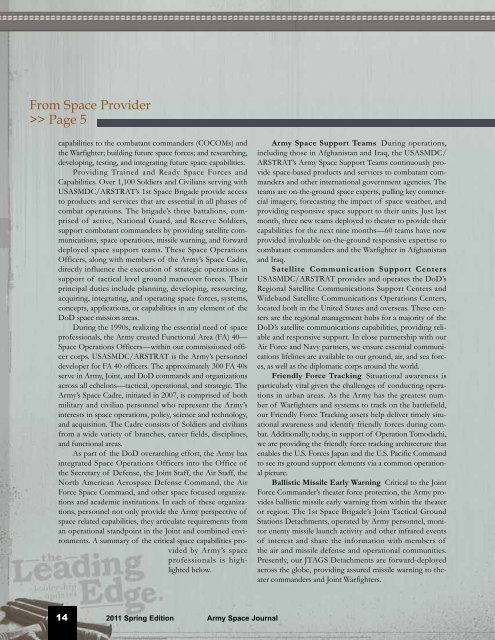Spring 2011 - Space and Missile Defense Command - U.S. Army
Spring 2011 - Space and Missile Defense Command - U.S. Army
Spring 2011 - Space and Missile Defense Command - U.S. Army
You also want an ePaper? Increase the reach of your titles
YUMPU automatically turns print PDFs into web optimized ePapers that Google loves.
From <strong>Space</strong> Provider<br />
>> Page 5<br />
capabilities to the combatant comm<strong>and</strong>ers (COCOMs) <strong>and</strong><br />
the Warfighter; building future space forces; <strong>and</strong> researching,<br />
developing, testing, <strong>and</strong> integrating future space capabilities.<br />
Providing Trained <strong>and</strong> Ready <strong>Space</strong> Forces <strong>and</strong><br />
Capabilities. Over 1,100 Soldiers <strong>and</strong> Civilians serving with<br />
USASMDC/ARSTRAT’s 1st <strong>Space</strong> Brigade provide access<br />
to products <strong>and</strong> services that are essential in all phases of<br />
combat operations. The brigade’s three battalions, comprised<br />
of active, National Guard, <strong>and</strong> Reserve Soldiers,<br />
support combatant comm<strong>and</strong>ers by providing satellite communications,<br />
space operations, missile warning, <strong>and</strong> forward<br />
deployed space support teams. These <strong>Space</strong> Operations<br />
Officers, along with members of the <strong>Army</strong>’s <strong>Space</strong> Cadre,<br />
directly influence the execution of strategic operations in<br />
support of tactical level ground maneuver forces. Their<br />
principal duties include planning, developing, resourcing,<br />
acquiring, integrating, <strong>and</strong> operating space forces, systems,<br />
concepts, applications, or capabilities in any element of the<br />
DoD space mission areas.<br />
During the 1990s, realizing the essential need of space<br />
professionals, the <strong>Army</strong> created Functional Area (FA) 40—<br />
<strong>Space</strong> Operations Officers—within our commissioned officer<br />
corps. USASMDC/ARSTRAT is the <strong>Army</strong>’s personnel<br />
developer for FA 40 officers. The approximately 300 FA 40s<br />
serve in <strong>Army</strong>, Joint, <strong>and</strong> DoD comm<strong>and</strong>s <strong>and</strong> organizations<br />
across all echelons—tactical, operational, <strong>and</strong> strategic. The<br />
<strong>Army</strong>’s <strong>Space</strong> Cadre, initiated in 2007, is comprised of both<br />
military <strong>and</strong> civilian personnel who represent the <strong>Army</strong>’s<br />
interests in space operations, policy, science <strong>and</strong> technology,<br />
<strong>and</strong> acquisition. The Cadre consists of Soldiers <strong>and</strong> civilians<br />
from a wide variety of branches, career fields, disciplines,<br />
<strong>and</strong> functional areas.<br />
As part of the DoD overarching effort, the <strong>Army</strong> has<br />
integrated <strong>Space</strong> Operations Officers into the Office of<br />
the Secretary of <strong>Defense</strong>, the Joint Staff, the Air Staff, the<br />
North American Aerospace <strong>Defense</strong> Comm<strong>and</strong>, the Air<br />
Force <strong>Space</strong> Comm<strong>and</strong>, <strong>and</strong> other space focused organizations<br />
<strong>and</strong> academic institutions. In each of these organizations,<br />
personnel not only provide the <strong>Army</strong> perspective of<br />
space related capabilities, they articulate requirements from<br />
an operational st<strong>and</strong>point in the Joint <strong>and</strong> combined environments.<br />
A summary of the critical space capabilities provided<br />
by <strong>Army</strong>’s space<br />
professionals is highlighted<br />
below.<br />
<strong>Army</strong> <strong>Space</strong> Support Teams During operations,<br />
including those in Afghanistan <strong>and</strong> Iraq, the USASMDC/<br />
ARSTRAT’s <strong>Army</strong> <strong>Space</strong> Support Teams continuously provide<br />
space-based products <strong>and</strong> services to combatant comm<strong>and</strong>ers<br />
<strong>and</strong> other international government agencies. The<br />
teams are on-the-ground space experts, pulling key commercial<br />
imagery, forecasting the impact of space weather, <strong>and</strong><br />
providing responsive space support to their units. Just last<br />
month, three new teams deployed to theater to provide their<br />
capabilities for the next nine months—60 teams have now<br />
provided invaluable on-the-ground responsive expertise to<br />
combatant comm<strong>and</strong>ers <strong>and</strong> the Warfighter in Afghanistan<br />
<strong>and</strong> Iraq.<br />
Satellite Communication Support Centers<br />
USASMDC/ARSTRAT provides <strong>and</strong> operates the DoD’s<br />
Regional Satellite Communications Support Centers <strong>and</strong><br />
Wideb<strong>and</strong> Satellite Communications Operations Centers,<br />
located both in the United States <strong>and</strong> overseas. These centers<br />
are the regional management hubs for a majority of the<br />
DoD’s satellite communications capabilities, providing reliable<br />
<strong>and</strong> responsive support. In close partnership with our<br />
Air Force <strong>and</strong> Navy partners, we ensure essential communications<br />
lifelines are available to our ground, air, <strong>and</strong> sea forces,<br />
as well as the diplomatic corps around the world.<br />
Friendly Force Tracking Situational awareness is<br />
particularly vital given the challenges of conducting operations<br />
in urban areas. As the <strong>Army</strong> has the greatest number<br />
of Warfighters <strong>and</strong> systems to track on the battlefield,<br />
our Friendly Force Tracking assets help deliver timely situational<br />
awareness <strong>and</strong> identify friendly forces during combat.<br />
Additionally, today, in support of Operation Tomodachi,<br />
we are providing the friendly force tracking architecture that<br />
enables the U.S. Forces Japan <strong>and</strong> the U.S. Pacific Comm<strong>and</strong><br />
to see its ground support elements via a common operational<br />
picture.<br />
Ballistic <strong>Missile</strong> Early Warning Critical to the Joint<br />
Force Comm<strong>and</strong>er’s theater force protection, the <strong>Army</strong> provides<br />
ballistic missile early warning from within the theater<br />
or region. The 1st <strong>Space</strong> Brigade’s Joint Tactical Ground<br />
Stations Detachments, operated by <strong>Army</strong> personnel, monitor<br />
enemy missile launch activity <strong>and</strong> other infrared events<br />
of interest <strong>and</strong> share the information with members of<br />
the air <strong>and</strong> missile defense <strong>and</strong> operational communities.<br />
Presently, our JTAGS Detachments are forward-deployed<br />
across the globe, providing assured missile warning to theater<br />
comm<strong>and</strong>ers <strong>and</strong> Joint Warfighters.<br />
14<br />
<strong>2011</strong> <strong>Spring</strong> Edition <strong>Army</strong> <strong>Space</strong> Journal
















